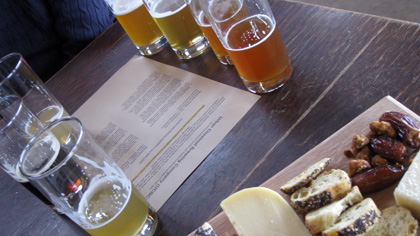 The topic for today’s 49th gathering of The Session is “regular beer.” Since I’m the host I offered to publish posts from readers who don’t maintain blogs. This is the second of two.
The topic for today’s 49th gathering of The Session is “regular beer.” Since I’m the host I offered to publish posts from readers who don’t maintain blogs. This is the second of two.
By Bill Farr (a semi-regular commenter here)
How I gained a regular beer and wrestled with virtually every issue related to “good beer”
The beer I drink most often is Arrogant Bastard Ale. For me to get to the point of having a regular beer, I managed to hit pretty much every topic that appears in the beer site forums – among others, scarcity’s perceived effect on flavor, variety, drinking “local,” the perceived quality of a brewery, the evils of marketing – and one that rarely gets addressed except to be quickly dismissed. I’ll close with that one.
I live in Illinois, and up until a year or two ago, Stone Brewing Co. didn’t bring their beers to Illinois. I learned of Arrogant Bastard years back through my brother-in-law, who had found a clone homebrew recipe for the beer in Zymurgy back in 2003. He tried the recipe and raved about it. I tried his brews, and he was right. Of course, who knew how the homebrew compared to the actual beer?
Well. I became aware that Stone was available in Indiana, and occasionally was able to cross the border and pick up their brews. Loved them. LOVED them. Waxed rhapsodic in written reviews. Especially loved Arrogant Bastard, and occasionally mentioned that it was my favorite beer, or one of two (neither of which I could get regularly). Wondered how much of this was due to only having a few bottles a year.
In the meantime, I drank like the stereotypical craft beer drinker as portrayed in, um, our literature. There was always a different beer or three in my fridge, and I was always trying something new. Believed in drinking local brews – frequented my local brewpub, drank a lot of brews from relatively local brewers. And . . . and eventually realized that certain brews and breweries kept re-appearing, because I liked their stuff.
And Stone entered the Illinois market. And by this time, there’s a backlash against Stone by some folks on the beer site forums – the beer’s too pedestrian, too gateway, too behind the times, no longer as good since they opened the larger brewery, too reliant on marketing, only as popular as it is because the company bullies others. “Huh,” I said, being unable to imagine a world where Arrogant Bastard would be deemed “pedestrian” or a “gateway” brew. And bought a bottle or three, and it was as good as it ever was.
And now I buy a bottle or two a week, and often it’s the only beer I drink in a given week. And I’ve learned a couple of things. One is that, for me, here’s a case where the beer’s former rarity didn’t make it taste better. It’s really good, and more often than not, it’s what I want to drink when I want beer. I explore other brews when I visit places, or when somebody recommends something, but . . . I’m not minding that, say, half the beer or more I drink in a given year is Arrogant Bastard. A corollary to this is that my experience drinking Arrogant Bastard and other Stone brews hasn’t provided any evidence of a change in quality in the beer produced by Stone over the years. Nor a diminishing in complexity, nor any evidence that other breweries have passed Stone by. Which suggests to me that the next great thing doesn’t mean it’s a thing not to be missed – I don’t need to try everything from every newly-loved and praised brewery. I don’t feel my life is somehow less full for not yet having the chance to try X, or perhaps never getting the chance to try Y. It’s ok. I’ve found things that bring me joy.
I’m a bit perturbed that my drinking locally has diminished, but . . . if my local breweries don’t produce something I want to drink as consistently, what do I do? Reduce my enjoyment? It’s tricky – rarely are all the ingredients of which a beer is made local to where the beer is made, so it comes down to local jobs and pride. And I guess that for me, if the local guys are able to sell all they make, I don’t have to feel guilty. It’s presumably going to folks who enjoy it as much as or more than I do.
Whether marketing is a bad thing — well, if people care, more power to them. The beer’s good.
So, having a regular beer has helped me make personal peace with many of the burning arguments on the RateBeer and BeerAdvocate forums. But it hasn’t helped me resolve one issue that rarely comes up on the forums except to be quickly dismissed. That issue is whether I (and others in the good beer community) drink too much for my (or for their) own good. Arrogant Bastard is over 7% abv, and only comes in a 22 oz. bottle. I already know I am susceptible to problems drinking — even a glass of beer or two at night might mess up my sleep and hence my effectiveness the next day, and a bomber of Arrogant Bastard is a bit more than a glass of beer. I know it affects my weight negatively, because I like to eat when I drink. And I know that, after a certain amount of alcohol, I’m going to want more alcohol. It’s here where the fact that Arrogant Bastard comes in single bombers rather than, say, six-packs helps — if I only buy one at a time, I can only drink one at a time. But that one bottle is still a lot of alcohol, and a lot of calories.
I’ve learned that it’s easy for me to stop drinking for weeks at a time, and that drinking socially is easy. But I also know how easy it is to drink too much in the comfort of my own home, and how easy it could be to do it all the time. And I read the folks who contribute to many of the beer site forums, and I wonder if the pursuit of enjoyment and camaraderie and connoisseurship has moved to the point of potentially dangerous drinking for many of them. And, well, to each their own, but no one does this in a vacuum, and there are family and friends and co-workers who are affected, and every time I see a “how do I convince my significant other it’s ok?” thread, I cringe. It’s not necessarily OK, and I wish we did a better job recognizing that. Beer is a great thing, and can bring joy and promote friendship. And yet it can bring pain and problems depending on what we do with it, be it session beer or wine-strength brew. We do ourselves a huge disservice by minimizing this aspect.
PS – By the way, that Zymurgy clone recipe for Arrogant Bastard? Surprisingly close!

 OK, maybe it depends on how much you were drinking while begging for beads, but for the sake of what follows let’s agree it would be a “regular beer.”
OK, maybe it depends on how much you were drinking while begging for beads, but for the sake of what follows let’s agree it would be a “regular beer.”